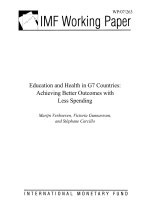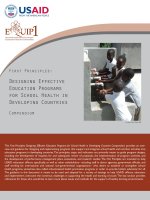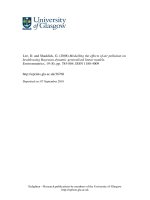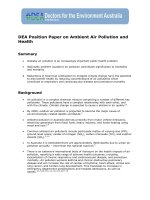Economics of Air Pollution and Health in Developing Countries: A Brief Literature Survey docx
Bạn đang xem bản rút gọn của tài liệu. Xem và tải ngay bản đầy đủ của tài liệu tại đây (187.93 KB, 11 trang )
.
Economics of Air Pollution and Health in
Developing Countries:
A Brief Literature Survey
S. Aaron Hegde
North Carolina State University
1
October 2, 2001
1
This work was commissioned by SANDEE. Thanks are due to Katy Bolt for
identifying some additional references included in this survey.
1. Summaries
Outdoor Air Pollution
(i) “Cost-of-Illness and Willingness-to-Pay Estimates of the Benefits of Improved
Air Quality: Evidence from Taiwan”- Alberini and Krupnik (2000).
Abstract: They compare cost-of-illness (COI) and willingness-to-pay (WTP)
estimates of the damages from minor respiratory symptoms associated with air
pollution using data from a study in Taiwan in 1991-92. A contingent valuation
survey is conducted to estimate WTP to avoid minor respiratory illnesses. Health
diaries are analyzed to predict the likelihood and cost of seeking relief from
symptoms and of missing work. As predicted by estimates, exceeding the latter by
1.61 to 2.26 times, depending on pollution levels. These ratios are similar to those
for the United States, despite the differences between the two countries.
(ii) “Health and Environmental Benefits from Air Pollution Reductions in
Hungary” - Aunan, Patzay, Aaheim and Seip (1998).
Abstract: The aim of this study is to assess the cost and benefit of the
implementation of a specific energy saving program in Hungary. They consider the
possible reduced damage to public health, building materials and agricultural crops
that may be obtained from reducing emissions of important air pollutants and also
how the program contributes to reduced emissions of greenhouse gases. The
measures are described in the National Energy Efficiency Improvement and Energy
Conservation Programs (NEEIECP), elaborated by the Hungarian Ministry of
Industry and Trade and accepted by the Government in 1994. The energy saving
expected from the program is approximately 64 PJ/year. The benefits were
estimated using monitoring data and population/ recipient data from urban and rural
areas in Hungary together with exposure-response functions and valuation estimates
mainly from western studies. Their analysis indicates that the main benefit from
reducing the concentrations of pollutants relates to public health and that reduced
prevalence of chronic respiratory diseases is an important effect. Reduced premature
mortality is also important and the estimated attributable risk of air pollution to
excess mortality at present is approximately 6%. The estimated annual benefit of
improved health conditions alone is likely to exceed the investments needed to
implement the program. In addition there are significant benefits due to reduced
replacement and maintenance costs for building materials (30–35 million US$
annually in Budapest only). The damage to crops due to ozone is large, but a
significant improvement in Hungary depends upon concerted actions in several
countries.
(iii) “Transferability of Air Pollution Control Health Benefits Estimates from the
United States to Developing Countries: Evidence from the Bangkok Study”,
Chestnut, Ostro and Vichit-Vadakan (1997)
Abstract: Countries around the world are experiencing increased level of air
pollution as a result of rapid increases in energy consumption and motor vehicle use,
a product of rapid population and economic growth. This paper focuses on the
benefits to human health through reductions in particulate matter air pollution, a
common pollutant in the urban environment. The authors summarizes the results of
a set of health effects and economic valuation studies conducted in Bangkok,
Thailand, concerning particulate matter air pollution and highlight what these results
imply regarding how transferable results from other countries are for assessing health
benefits of particulate matter reductions in Bangkok. Comparing the willingness-to-
pay (WTP) values from Bangkok to U.S. estimates, this study finds that Bangkok
residents are willing to pay a higher share of their income to protect their health. A
plausible explanation provided for this result is that health may be seen as a basic
necessity like food and shelter.
(iv) “The Health Benefits of Air Pollution Control in Delhi” -
Cropper, Simon,
Alberini, Arora and Sharma (1997)
Abstract: This paper reports the results of a study relating levels of particulate
matter to daily deaths in Delhi, India, between 1991 and 1994. The focus is on Delhi
because it is one of the world’s most polluted cities. This study concludes: (a) The
impact of particulate matter on total non-trauma deaths in Delhi is smaller than
effects found in the United States. (b) The impacts of air pollution on deaths by age-
group may be very different in developing countries than in the United States, where
peak effects occur among people aged sixty-five and older. In Delhi, peak effects
occur between the ages of fifteen and forty-four, implying that a death associated
with air pollution causes more life-years to be lost.
(v) “Air Pollution and Acute Respiratory Illness: Evidence from Taiwan and Los
Angeles” – Alberini and Krupnik (1997)
Abstract: This paper explores the appropriateness of concentration-response
function transfers by comparing two health studies conducted following a similar
format – but years apart- in Los Angeles and Taiwan. Daily records from a diary-
type epidemiological study are used to fit logit equations predicting the probability of
experiencing minor acute respiratory symptoms as a function of pollution and
weather variables, individual characteristics, and health background and proxies for
reporting effects.
(vi) “The Economics of Air Pollution Health Risks in Russia: A case study of
Volgograd”- Larson, Avaliani, Golub, Rosen, Shaposhnikov, Strukova, Vincent
(1999)
Abstract : A combined health risk assessment, cost-effectiveness analysis, and
benefit-cost analyssi is undertaken for direct particulate emissions from 29 stationary
source polluters in the city of Volgograd, Russia. Annual particulate-related
mortality risk from these stationary sources are estimated to be substantial, with an
estimate in the range of 960- 2,667 additional deaths per year in this city of one
million. The majority of these risks are attributed to two major facilites in the
northern part of the city. For several emission reduction projects, the cost-per-life
saved was estimated to be quite low. The total net benefits to the city of
implementing five of the six identified projects, leading to roughtly a 25% reduction
in mortality risk, are estimated to be at least $40 million in present value terms.
(vii) “The Health Costs of Motor-Vehicle-Related Air Pollution” – McCubbin and
Delucchi, (1999).
Abstract: Motor vehicles have significantly larger health costs than previously
reported. Particulates are the most damaging pollutant, while ozone and other
pollutants have smaller effects. Diesel vehicles cause more damages per mile than do
gasoline vehicles, because of greater particulate emissions. Very fine particles appear
more dangerous than larger particles, and combustion particles appear more
dangerous than road dust. The possibility cannot be ruled out that ozone is linked to
mortality and chronic illness, effects which are costly and would considerably raise
the costs of ozone pollution. These results suggest that emphasis should be placed
on the regulation of particulates.
(viii) “Economic Valuation and Health Damage from Air Pollution in the Developing
World”- Pearce, (1996).
Abstract: Meta studies of air pollution epidemiology have resulted in the use of
transferable dose-response coefficients whereby the statistical relationship between
air pollution and human health is applied outside the countries of the original studies.
The aim is to predict changes in premature mortality and morbidity. Some studies
then apply economic valuations in order to see if health damage from air pollution
should be treated as a priority concern in the countries to which the coefficients are
applied. Preliminary work suggests that some forms or air pollution, notably
inhalable particulate matter and ambient lead, are serious matters for concern in the
developing world.
(ix) “Assessing Health Impacts of Air Pollution from Electricity Generation: The
Case of Thailand”, Thanh and Lefevre (2000)
Abstract: They apply the impact pathway approach (IPA) to estimate health
impacts and corresponding damage costs of sulfur dioxide (SO
2
) and emissions of
fine particulate matter (PM10) from four power units using different fuels (lignite,
oil, natural gas, and coal) at four locations in Thailand. The results show that the
damage cost related to health effects of electricity generation in Thailand are
relatively small, but not negligible, ranging from 0.006 U.S. cent to 0.05 U.S. cent per
kilowatt-hour (in 1995 dollars). Damage costs to the public health due to SO
2
and
PM10 emissions from electricity generation not only depend on fuel and generating
technology but also depend strongly on power plant location. This implies that the
assessment of adverse health impacts is very important for technology choice and
siting of new power plants.
Indoor Air Pollution
(x) “A Scoping Study on the Costs of Indoor Air Quality Illnesses: Ann Insurance
Loss Reduction Perspective” - Chen and Vine (1999)
Abstract: The number of indoor air quality (IAQ)- related health complaints in
commercial buildings, and the frequency of litigation over the effects of poor IAQ is
increasing. These increases have ramifications for insurance carriers, which pay for
many of the costs of health care and general commercial liability. However,
insurance companies know little about the actual costs from poor IAQ in buildings.
This paper reports on the results of a literature search of buildings-related, business
and legal databases, and interviews with insurance and risk management
representatives aimed at finding information on the direct costs to the insurance
industry of poor building IAQ, as well as the costs of litigation. The literature search
turned up little specific cost information, but indicated that there is strong awareness
and growing concern over the “silent crisis” of IAQ and its potential to cause large
industry losses. The source of these losses includes both direct costs to insurers
from paying health insurance and professional liability claims as well as the cost of
litigation. In spite of the lack of data on how IAQ-related health problems affect
their business, the insurance industry has taken the anecdotal evidence about their
reality seriously enough to alter their policies in ways that have lessened their
exposure.
(xi) “National burden of disease in India from indoor air pollution” – Smith
(2000)
Abstract: In the last decade, a number of quantitative epidemiological studies of
specific diseases have been done in developing countries that for the first time allow
estimation of the total burden of disease (mortality and morbidity) attributable to use
of solid fuels in adult women and young children, who jointly receive the highest
exposures because of their household roles. Few such studies are available as yet for
adult men or children over 5 years. This paper evaluates the existing epidemiological
studies and applies the resulting risks to the more than three-quarters of all Indian
households dependent on such fuels. Allowance is made for the existence of
improved stoves with chimneys and other factors that may lower exposures.
Attributable risks are calculated in reference to the demographic conditions and
patterns of each disease in India. Sufficient evidence is available to estimate risks
most confidently for acute respiratory infections (ARI), chronic obstructive
pulmonary disease (COPD), and lung cancer. Estimates for tuberculosis (TB),
asthma, and blindness are of intermediate confidence. Estimates for heart disease
have the lowest confidence. Insufficient quantitative evidence is currently available to
estimate the impact of adverse pregnancy outcomes (e.g., low birthweight and
stillbirth). The resulting conservative estimates indicate that some 400-550 thousand
premature deaths can be attributed annually to use of biomass fuels in these
population groups. Using a disability-adjusted lost life-year approach, the total is 4-
6% of the Indian national burden of disease, placing indoor air pollution as a major
risk factor in the country.
2. References
(i) Journal Articles
Outdoor Air Pollution – Developing Countries
Alberini, Anna and Alan Krupnick, 2000. “Cost-of-Illness and WTP Estimates of the
Benefits of Improved Air Quality: Evidence from Taiwan”, Land Economics 76(1), February
2000
Aunan, K et al., 1998. “Health and Environmental Benefits from Air Pollution Reductions
in Hungary”, The Science of the Total Environment, 212: 245-268.
Chaaban, F.B., I. Nuwayhid, S. Djoundourian, 2001. “A Study of Social and Economic
Implications of Mobile Sources on Air Quality in Lebanon”, Transportation Research Part D, 6,
347-355.
Chestnut, L.G., Ostro, B.D. and N. Vichit-Vadakan, 1997. “Transferability of Air Pollution
Control Health Benefits Estimates from the United States to Developing Countries:
Evidence from the Bangkok Study”, American Journal of Agricultural Economics; 79, 1630-35.
Cropper, Maureen, et al., 1997. “The Health Benefits of Air Pollution Control in Delhi”,
American Journal of Agricultural Economics, 79, 1625-1629.
Cropper, Maureen, et al., 1997. “Valuing Health Effects of Air Pollution in Developing
Countries: The Case of Taiwan”, Journal of Environmental Economics and Management, 34, 107-
126.
El-Fadel, M. and M. Massoud, 2000. “Particulate Matter in Urban Areas: Health-Based
Economic Assessments”, The Science of the Total Environment, 257, 133-146.
Eskelund, Gunnar S., 1997. “Air Pollution Requires Multipollutant Analysis: The Case of
Santiago, Chile”, American Journal of Agricultural Economics, 79: 1636-1641.
Krupnik, Alan and Anna Alberini. 1997, “Air Pollution and Acute Respiratory Illness:
Evidence from Taiwan and Los Angeles” , American Journal of Agricultural Economics, 79, 1620-
1624.
Kwak, Seung-Jun, Seung-Hoon Yoo and Tai-Yoo Kim, 2001. “A Constructive Approach to
Air-Quality Valuation in Korea”, Ecological Economics., 38, 327-344.
Larson, Bruce A., et al., 1999. “The Economics of Air Pollution Health Risks in Russia: A
case study of Volgograd”, World Development, 10, 1803-1819.
O’Ryan, R. E., 1996, “ Cost –Effective Policies to Improve Urban Air Quality in
Santiago, Chile” Journal of Environmental Economics and Management, vol 31,
Number 1996.
Ostro, B., et al., 1996. “Air Pollution and Mortality: Results from a Study of Santiago, Chile”,
Journal of Exposure Analysis and Environmental Epidemiology, 6, 97-114.
Pearce, David, 1996. “Economic Valuation and Health Damage from Air Pollution in the
Developing World”, Energy Policy, 24(7): 627-630.
Romieu, I., H. Weitzenfeld, and J. Finkelman, 1990, “ Urban Air Pollution in Latin
America and Caribbean: Health Perspectives” World Health Statistics Quarterly, vol
43, pp 153-167.
Thanh, Bui Duy and Thierry Lefevre, 2000. “Assessing Health Impacts of Air Pollution
from Electricity Generation: The Case of Thailand”, Environmental Impact Assessment Review,
20, 137-158.
Working Group on Public Health and Fossil Fuel Combustion, 1997. “Short Term
Improvements in Public Health From Global Climate Policies on Fossil Fuel Combustion:
An Interim Report”, The Lancet, 350, 1341-1349.
Xu, X. , J. Gao, D. W. Dockery, and Y. Chen, 1994, “ Air Pollution and daily Mortality
in Residential Area of Beijing, China” Archives of Environmental Health, vol 49,
Number 4, pp 216-22.
Outdoor Air Pollution- Developed Countries
McCubbin, Donald R., Mark A. Delucchi, 1999. “The Health Costs of Motor-Vehicle-
Related Air Pollution”, Journal of Transport Economics and Policy, 33(3), 253-286.
Ransom, Michael R., and Arden C. Pope III, 1995. “External Health Costs of a Steel Mill”,
Contemporary Economic Policy, 13(2), 86-97.
Smith, K.R., Corvalan, C.F. and T. Kjellstrom, 1999. "How Much Global Ill Health is
Attributable to Environmental Factors?", Epidemiology, 10, 573-584.
Indoor Air Pollution
Chen, Allen and Edward L. Vine, 1999. “A Scoping Study on the Costs of Indoor Air
Quality Illnesses: An Insurance Loss Reduction Perspective”, Environmental Science and Policy,
2, 457-464.
Smith, K.R., 2000. “National burden of disease in India from indoor air pollution” in the
Proceedings of the National Academy of Sciences of the United States of America
(PNAS 2000 97: 13286-13293).
Smith, K.R., 2000. “Fuel Efficiency of An Improved Woodburning Stove in Rural
Guatamala: Implications for Health, Environment, and Development” – Energy for Sustainable
Development, 4(2): 21-29
/>
Smith, K.R., 1999. "Secondary Benefits of Greenhouse Gas Control: Health Impacts in
China"- Environmental Science Technology, 33:3056-3061
Smith, K.R., 1999. "Near-Term Health Benefits of Greenhouse Gas Reductions: A Proposed
Assessment Method and Application in Two Energy Sectors of China" – WHO, March 1999
Smith, K.R., 1999. "Indoor Air Pollution", Pollution Management Discussion Note, Number 4,
The World Bank, August 1999.
Yang, Chun-Yu, Jeng-Fen Chiu, Ming-Fen Chen and Meng-Chiao Lin, 1997. “Effects of
Indoor Environmental Factors on Respiratory Health of Children in a sub-tropical climate.
Environmental Research, 75, 49-55
“Quantifying the Effects of Exposure to Indoor Air Pollution from Biomass Combustion
on Acute Respiratory Infections in Developing Countries,” Environmental Health
Perspectives, Volume 109, Number 5, pages 481 – 488, May 2001. URL:
“Acute respiratory infection and indoor air pollution from biomass combustion in Kenya:
an exposure-response study,” The Lancet, August 25 issue of The Lancet, Volume 358,
pages 619 – 624, August 25, 2001.
Indoor.
p
df
Air Pollution – Methodology
Engler, Norbert, 1999. “Time Series Analysis and Cohort Studies to Investigate
Relationships between particular matter and mortality – two approaches to one end point”,
Journal of Environmental Medicine, 1(4), Oct/ Dec 1999, 291-296.
Pitard, A. and J.F. Viel, 1999. “A Model Selection Tool in Multi-Pollutant Time Series: the
Granger Causality Diagnosis”, Envirometrics, 10(1), Jan/ Feb 1999, 53-65.
Rosan, Anne, 2001. “How to Measure Health Costs Induced by Air Pollution?”,
Schweizerische-Zeitschrift-fur-Volkswirtschaft-undStatistik/Swiss-Journal-of-Economics-and-Statistics,
137(1), 103-116.
(ii) Working Papers
Burtraw, Dallas and Alan Krupnik, 1999. “Measuring the Value of Health Improvements
from Great Lakes Cleanup”, RFF, Discussion Paper 99-34 .
CSERGE (1998), 'Benefits Transfer and the Economic Valuation of Environmental
Damage in the European Union: With Special Reference to Health', EU-DGXII
Dasgupta, S., H. Wang and D. Wheeler, 1997, Surviving Success: Policy Reform and the
Future of Industrial Pollution in China, World Bank Policy Research Working Paper, No.
1856, October (
DSS Management Consultants Inc, 2000. “Estimating Health and Economic Damages:
Illness Costs of Air Pollution”, Report submitted to Ontario Medical Association, July 26, 2000.
Department of the Environment, Transport and the Regions, 1999. An Economic Analysis
of the National Air Quality Strategy Objectives: An Interim Report.
Dixon, John A., “The Economic Valuation of Health Impacts”, World Bank Report
/>4a/c2b8735dfad817f08525671c007d28a0/$FILE/HEALTH.pdf
Environmental Health Project, 1999. "Lowering Exposure of Children to Indoor Air
Pollution to Prevent ARI: The Need for Information and Action", Capsule Report Number 3,
January 1999. />
Lvovsky, K., G. Hughes, D. Maddison, B. Ostro, D. Pearce. (2000). Environmental Costs
of Fossil Fuel: A Rapid Assessment Method with Application to Six Cities. Environment
Department Paper No. 89. (World Bank, Washington DC.)
Ostro, Bart D. et al., 1998. “Air Pollution and Health Effects: A Study of Respiratory Illness
among Children in Santiago, Chile”, World Bank working paper, March 1998.
/>/wps1932.pdf
Ostro, B., 1994, "Estimating the Health Effects of Air Pollutants: A Method with an
Application to Jakarta," World Bank, Policy Research Department Working Paper, No.
1301.(
O’Ryan, R. E., 1995, “ Emissions Trading in Santiago; An Overview”, World Bank
Effective Financing of Environmentally Sustainable Development, Environmentally
Sustainable Development Proceedings Series No. 10.
Wells, G. J., X. P. Xu, and T. M. Johnson, 1994 “ Valuing the Health Effects of Air
Pollution: Application to Industrial Energy Efficiency Projects in China” World Bank
World Bank, 1997, Clear Water Blue Skies: China 2020- China’s Environment in the
New Century, World Bank.
World Health Organization, 1997, Assessment of Exposure to Indoor Air Pollutants,
WHO Regional Publications, European Series, No. 78.
World Health Organization 1999, Air Quality Guidelines,
_information/Air/Guidelines
(iii) Books
Cannon, Terry, edited, 2000. China’s Economic Growth: The Impact on Regions,
Migration and the Environment. MacMillan Press, London: 2000.
Department of Health (1999), Economic Appraisal of the Health Effects of Air Pollution,
Ad-Hoc Group on Economic Appraisal of the Health Effects of Air Pollution, The
Stationery Office, London
Florig, H. (1993). The Benefits from Air Pollution Reduction in China. (Resources for
the Future, Washington, DC.)
IBRD, World Bank, 2001. China Air, Land, and Water: Environmental Priorities for a
new millennium.
Pearce, D. and Maddison, D. (1999), 'Estimating the Health Damage Costs of Air
Pollution', in Holgate, S., Koren, H., Samet, J. and Maynard, R. (Eds), Air Pollution and
Health, Academic Press, London, pp917-928.
Saroa da Motta, Ronaldo and Ana-Paula Fernades-Mendes, 1996. “Health Costs Associated
with Air Pollution in Brazil”, in Peter May edited Pricing the planet: Economic analysis for
sustainable development. New York: Columbia University Press. pp 101-122.
Tisdell, Clement A., and Joseph Chai (Eds.), 1997. China’s Economic Growth and
Transition: Macroeconomic, Environmental and Social/ Regional Dimensions. Nova
Science Publishers, Inc, Commack, NY: 1997.
Wang, H., and D. Wheeler, 1996. “Pricing Industrial pollution control in China: An
Econometric Analysis of the Levy System”, World Bank Policy Research Department Working
Paper, No. 1644
Wilson, R., and J. D. Spengler eds, 1996. Particles in Our Air: Concentrations and Health
Effects, Cambridge, MA: Harvard University Press.









